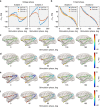Electric field dynamics in the brain during multi-electrode transcranial electric stimulation
- PMID: 31189931
- PMCID: PMC6561925
- DOI: 10.1038/s41467-019-10581-7
Electric field dynamics in the brain during multi-electrode transcranial electric stimulation
Abstract
Neural oscillations play a crucial role in communication between remote brain areas. Transcranial electric stimulation with alternating currents (TACS) can manipulate these brain oscillations in a non-invasive manner. Recently, TACS using multiple electrodes with phase shifted stimulation currents were developed to alter long-range connectivity. Typically, an increase in coordination between two areas is assumed when they experience an in-phase stimulation and a disorganization through an anti-phase stimulation. However, the underlying biophysics of multi-electrode TACS has not been studied in detail. Here, we leverage direct invasive recordings from two non-human primates during multi-electrode TACS to characterize electric field magnitude and phase as a function of the phase of stimulation currents. Further, we report a novel "traveling wave" stimulation where the location of the electric field maximum changes over the stimulation cycle. Our results provide a mechanistic understanding of the biophysics of multi-electrode TACS and enable future developments of novel stimulation protocols.
Conflict of interest statement
A.O. is an inventor on patents and patent applications describing methods and devices for noninvasive brain stimulation. The remaining authors declare no competing interests.
Figures







References
Publication types
MeSH terms
Grants and funding
LinkOut - more resources
Full Text Sources
Other Literature Sources

